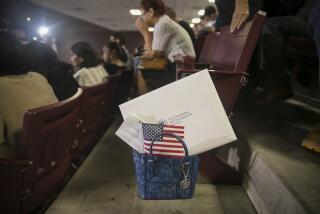Letters from immigration detention centers paint a dark picture, volunteers say
SAN DIEGO — Decades from now, when historians try to make sense of how the U.S. government treated detained migrants, they will be able to hear directly from the men and women in federal immigration detention centers.
At least that’s the hope of Lisa Lamont, head librarian at San Diego State, who oversees a collection of more than 1,700 letters written by migrants in detention centers.
“In 20, 30, or 40 years, or even longer down the road, when researchers are researching this time in U.S. history, I think these letter are going to be invaluable,” she said.
The population of people in Immigration and Customs Enforcement custody has grown significantly under the Trump administration. During fiscal year 2015 there were 28,449 immigrants in detention facilities. That number increased to 38,106 and 42,188 in the 2017 and 2018 fiscal years, respectively. Projections show that number is expected to increase to 52,000 by the 2020 fiscal year, according to data from the federal government.
The letters, mostly handwritten on blank paper, detail poor conditions inside detention centers such as detainees being served rotten food, receiving poor medical treatment and harsh treatment by staff. Additionally, the letters shed light on events driving migration to the United States.
For example, a letter from a 29-year-old Cameroonian national who has spent more than 15 months in detention describes violent conflicts between English speakers and the French-speaking population in his home country.
“I came here in U.S. seeking for protection because of what is happening in my country Cameroon because my country is a bilingual country where the English minority are been torture, kill, arrested and jail for a very long time or arrested and kill by the french government in Cameroon all because the Anglophone minority called southern Cameroon want secession from French Cameroon which cause many of my English Cameroonian to escape for their dear life,” he wrote.
According to his letter, the man could not be released from the detention center because he could not afford to pay a $50,000 bond.
The letters also offer details about the day-to-day operations of detention centers that are seldom seen in public.
One Guatemalan migrant wrote down the cost of everything sold inside the commissary at Otay Mesa Detention Center. It costs $2.52 for a bag of beans, $5.71 for a bag of milk, $1.26 for a Snickers bar, $13.70 for a pair of shorts, $2.62 for a bar of Dove soap.
Detainees in the detention center reportedly work for $1 a day, meaning it takes more than a day’s wages to buy a bag of potato chips.
Researchers at San Diego State work with the nonprofit Detainee Allies to receive and catalog the letters.
The nonprofit has a team of volunteers who visit and write to detainees. It also connects some detainees with lawyers and deposits money in their commissary accounts so that detainees can buy food, clothes or phone time to call their families.
Not all letters are published. And those that are, are redacted.
Researchers have to strike a careful balance between accurately portraying life in detention and protecting each detainee’s identity and privacy, said Lamont, the university librarian.
“It’s a balance between making sure that we redact anything that would cause any issues for anyone and leaving enough of the story to make sure people know what is happening,” she said.
Other nonprofits are doing similar work.
Cindy Knoebel is a volunteer editor of Immprint, a website that publishes letters from detainees and is affiliated with the nonprofit Freedom for Immigrants.
The nonprofit made national headlines this year because it was behind a hotline number that detainees could call for help. As many as 14,500 people used the hotline each month. Immigration and Customs Enforcement shut it down after it was featured on the television show “Orange is the New Black.”
On Tuesday, the nonprofit sued the federal government for pulling the plug on the hotline, claiming that ICE is violating the 1st Amendment rights of both detainees and volunteers.
“ICE’s shutdown of the Hotline violates FFI’s First Amendment rights to be free from retaliation for engaging in protected speech, and to speak freely to, and associate with, persons in immigration detention,” the lawsuit states. “The shutdown also violates the First Amendment rights of detained immigrants, who, without the Hotline, either are unable to contact FFI at all or can only do so by paying exorbitant fees, as calls can cost upwards of $1 a minute. Just as the First Amendment protects the right to speak, so too does it guarantee that one will not be punished for exercising that right.”
Like Detainee Allies, Freedom for Immigrants also has a network of volunteers who visit detention centers and ask people to write letters.
The letters include people sharing their stories, poetry and artwork, asking for legal aid and money to call relatives, or just asking for someone to visit them in detention.
If detainees sound particularly desperate, Knoebel will write them back herself to show that there is another human being acknowledging what they are going through, she said.
“I have not received one letter from a person in detention who says that the conditions are anything but physical and emotional torture,” she said. “The letters that I have break my heart every time I open an envelope.”
CoreCivic, the private company that manages Otay Mesa Detention Center has repeatedly pointed to the fact that Immigration and Customs Enforcement has given the detention center a 100% grade on annual audits as a sign of good performance.
The company also notes that the center, which opened in 2015, is a LEED (Leadership in Energy and Environmental Design) certified facility that is independently accredited by the American Correctional Association and is monitored on a daily basis by on-site ICE officials.
Solis writes for the San Diego Union-Tribune.
More to Read
Sign up for Essential California
The most important California stories and recommendations in your inbox every morning.
You may occasionally receive promotional content from the Los Angeles Times.











